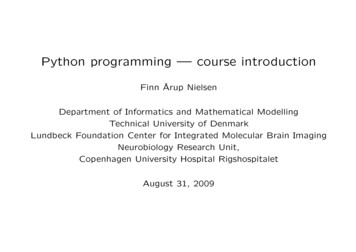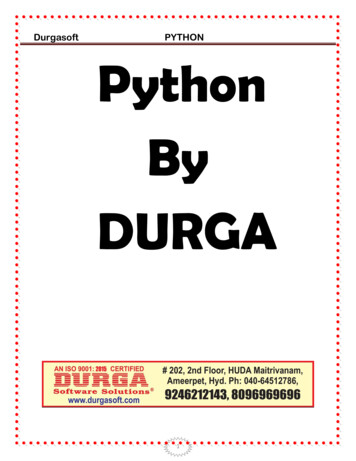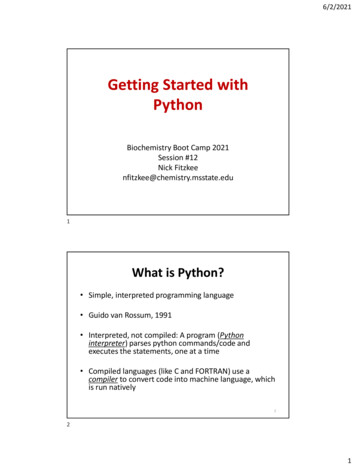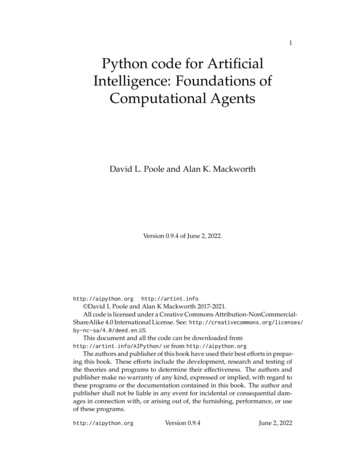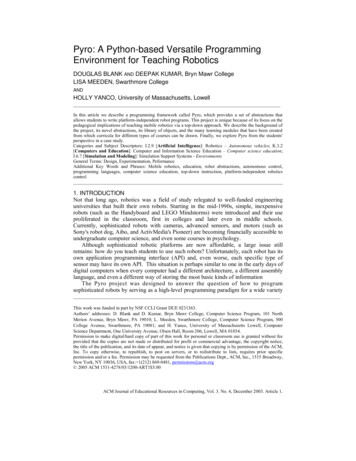
Transcription
Pyro: A Python-based Versatile ProgrammingEnvironment for Teaching RoboticsDOUGLAS BLANK AND DEEPAK KUMAR, Bryn Mawr CollegeLISA MEEDEN, Swarthmore CollegeANDHOLLY YANCO, University of Massachusetts, LowellIn this article we describe a programming framework called Pyro, which provides a set of abstractions thatallows students to write platform-independent robot programs. This project is unique because of its focus on thepedagogical implications of teaching mobile robotics via a top-down approach. We describe the background ofthe project, its novel abstractions, its library of objects, and the many learning modules that have been createdfrom which curricula for different types of courses can be drawn. Finally, we explore Pyro from the students'perspective in a case study.Categories and Subject Descriptors: I.2.9 [Artificial Intelligence]: Robotics – Autonomous vehicles; K.3.2[Computers and Education]: Computer and Information Science Education – Computer science education;I.6.7 [Simulation and Modeling]: Simulation Support Systems - EnvironmentsGeneral Terms: Design, Experimentation, PeformanceAdditional Key Words and Phrases: Mobile robotics, education, robot abstractions, autonomous control,programming languages, computer science education, top-down instruction, platform-independent roboticscontrol1. INTRODUCTIONNot that long ago, robotics was a field of study relegated to well-funded engineeringuniversities that built their own robots. Starting in the mid-1990s, simple, inexpensiverobots (such as the Handyboard and LEGO Mindstorms) were introduced and their useproliferated in the classroom, first in colleges and later even in middle schools.Currently, sophisticated robots with cameras, advanced sensors, and motors (such asSony's robot dog, Aibo, and ActivMedia's Pioneer) are becoming financially accessible toundergraduate computer science, and even some courses in psychology.Although sophisticated robotic platforms are now affordable, a large issue stillremains: how do you teach students to use such robots? Unfortunately, each robot has itsown application programming interface (API) and, even worse, each specific type ofsensor may have its own API. This situation is perhaps similar to one in the early days ofdigital computers when every computer had a different architecture, a different assemblylanguage, and even a different way of storing the most basic kinds of informationThe Pyro project was designed to answer the question of how to programsophisticated robots by serving as a high-level programming paradigm for a wide varietyThis work was funded in part by NSF CCLI Grant DUE 0231363.Authors’ addresses: D. Blank and D. Kumar, Bryn Mawr College, Computer Science Program, 101 NorthMerion Avenue, Bryn Mawr, PA 19010; L. Meeden, Swarthmore College, Computer Science Program, 500College Avenue, Swarthmore, PA 19081; and H. Yanco, University of Massachusetts Lowell, ComputerScience Department, One University Avenue, Olsen Hall, Room 206, Lowell, MA 01854.Permission to make digital/hard copy of part of this work for personal or classroom use is granted without feeprovided that the copies are not made or distributed for profit or commercial advantage, the copyright notice,the title of the publication, and its date of appear, and notice is given that copying is by permission of the ACM,Inc. To copy otherwise, to republish, to post on servers, or to redistribute to lists, requires prior specificpermission and/or a fee. Permission may be requested from the Publications Dept., ACM, Inc., 1515 Broadway,New York, NY 10036, USA, fax: 1(212) 869-0481, permissions@acm.org 2005 ACM 1531-4278/03/1200-ART1 5.00ACM Journal of Educational Resources in Computing, Vol. 3. No. 4, December 2003. Article 1.
2 D. Blank et al.of robots and sensors. Pyro, which stands for Python Robotics, is a Python-based roboticsprogramming environment that enables students and researchers to explore topics inrobotics. Programming robot behaviors in Pyro is akin to programming in a high-levelgeneral-purpose programming language in that Pyro provides abstractions for low-levelrobot-specific features much like the abstractions provided in high-level languages.Consequently, robot control programs written for a small robot (such as the K-Team'shockey puck-sized, infrared-based Khepera robot) can be used without any modificationsto control a much larger robot (such as ActivMedia's human-scale, laser-basedPeopleBot). This represents an advance over previous robot programming methodologiesin which robot programs were written for specific motor controllers, sensors,communications protocols, and other low-level features.Programming robot behaviors is carried out using the programming language, Python,which enables several additional pedagogical benefits. We have developed an extensiveset of robot programming modules, modeling techniques, and learning materials that canbe used in graduate and undergraduate curricula in a variety of ways. In the followingsections we present an overview of the abstractions incorporated into Pyro that havemade it possible to make robot programs portable across platforms. We also presentseveral examples that illustrate Pyro’s ease of use in different modeling situations.Finally, we examine the role of Pyro in computer science curricula by presenting adetailed case study of its use in an artificial intelligence course.2. OVERVIEW OF PYROThe need for a project like Pyro grew out of our desire to teach mobile robotics in acoherent, abstract, and robot-independent manner. For example, we wished to start withsimple "direct control" programs running on simple robots and to incrementally takestudents on a tour of other control paradigms running on increasingly sophisticatedrobots. There are many freely available, feature-rich, real-world control systems whichone can download, program, and run. For example, Carnegie Mellon has made theirRobot Navigation Toolkit (a.k.a. CARMEN) available as open source, and ActivMedia'sARIA is also freely available. However, all such programs that we encountered sufferedfrom three separate problems.Most existing robot control programs are designed to run on a single type of robot. Atbest, some of the robot control systems we found ran on a few types of robots, but eventhen the types had to be of similar size, shape, and abilities. Second, we wanted thecontrol system to be something that could be studied, and changed, by the students. All ofthe existing systems we encountered were designed to be as efficient as possible, andwere therefore filled with optimizations that obfuscated their overall design to the student.In addition, we were unable to find a system where we could easily separate the"controller" from the rest of the system. For example, a control system based onoccupancy grids might be intimately tied to a particular type of robot and laser scanner.It should not be a surprise that existing systems suffer from these limitations, sincemost of these projects were research explorations of a particular paradigm running on aparticular robot. Even, however, if we had found a series of programs to run on ourrobots, we would not have been able to incrementally make small changes to thecontroller to take us from one paradigm to another, nor would we have been able to mixparts of one paradigm with parts of another. However, there were two projects that didmeet some of our requirements.The first of these is TeamBots [Balch 2004], which is written in Java and, therefore, isobject-oriented with the possibility of many appropriate abstractions for teaching.TeamBots was designed such that the hardware interfaces and controllers are independentof one another. Thus, one can write a control program without worrying about low-levelACM Journal of Educational Resources in Computing, Vol. 3. No. 4, December 2003.
Pyro: A Python-Based Programming Environment 3details of the particular robot that it is controlling [Balch 1998]. At the time TeamBotswas written (1997-2000) the idea of using Java to control mobile robotics was quiterevolutionary. However, the TeamBots authors argue that "the benefits of Java(correctness, ease of use, rapid development) far outweigh the negligible runtimeoverhead" [Balch 2004]. We very much agree with this philosophy. In fact, we wanted totake the philosophy of "ease-of-use over runtime considerations" even further. AlthoughJava is arguably easier to use than, say, C or C , it still has a large conceptual overhead.The other project that met some of our requirements was the Player/Stage project[Gerkey 2003], first released in 2001. Player/Stage is actually three separate projects:Player, which is an evolving set of client/server protocols for communicating with robotsand simulators; Stage, a "low-fidelity", 2-D multi-robot simulator; and Gazebo, a "highfidelity", 3-D simulator. Because the Player/Stage authors have their software running onso many different kinds of robots, they have developed many useful robot and sensorabstractions. Whereas TeamBots only supported two different kinds of robots (Probotic'sCye and the now defunct Nomadic Technologies Nomad 150), Player/Stage supportsliterally dozens of robots: from K-Team's Khepera to Segway's RMP (a customizedversion of their Human Transport). However, all of Player/Stage is written in the Clanguage and is designed to operate as efficiently as possible. Although such efficiency isrequired by many control systems, such optimized code often obscures the high-leveldesign concepts. As mentioned, we were very willing to trade runtime efficiency for easeof-use (and ease-of-understanding). Player/Stage was not designed to be used by noviceprogrammers.In the end, we decided to build our own control system. We created a prototype usingthe extensible modeling language XML in combination with C [Blank 1999].Basically, the code looked like HTML with C code between the tags. Although thissystem had some nice qualities derived from its XML roots, it turned out to have all thecomplexities of XML and C combined, and was therefore difficult for students to learnand debug. For example, even syntax errors could be hard to track down because therewere two levels of parsing (one at the XML level, and another at the C level). Inaddition, like many of the other available control systems, we became bogged down inlow-level interface issues, and never reached the point of implementing more than onecontrol paradigm.Having learned from this prototype, we decided to try again, but this time the primaryfocus was on usability from the student perspective. We found that the Python languagemet many of our goals. To our surprise, we also found that Python had recently been usedto solve real-world complex programming problems. For example, Prechelt [2000] foundin some specific searching and string-processing tests that Python was better than Java interms of run-time and memory consumption, and not much worse than C or C in somesituations. In this incarnation, we set out with the following goals: be easy for beginning students to use;provide a modern object-oriented programming paradigm;run on several robot platforms and simulators;allow exactly the same program to control different kinds of robots;allow exploration of many different robot control paradigms andmethodologies;scale-up conceptually by remaining useful as users gain expertise;be extendible;allow creation of modern-looking visualizations; andbe available freely for study, use, and further development.ACM Journal of Educational Resources in Computing, Vol. 3. No. 4, December 2003.
4 D. Blank et al.Python is an ideal language for implementing these goals; in fact, it itself is driven bysimilar ideals, e.g., Python supports many different programming paradigms withoutmaking strong commitments to any. Although we can write complete Python programswithout ever defining a function, we can also use functions as first-class objects. As theuser grows in sophistication, so can the language. Figure 1 shows three paradigms forprinting "Hello world!" (1) a simple, direct method; (2) a method using functions; and (3)an object-oriented method. We can see that more complex paradigms build on syntax andconcepts from simpler paradigms. Java, on the other hand, does not allow students tostart with simple expressions and statements and slowly increase the level of conceptsand syntax, but rather forces the user to embrace the full object-oriented methodologyfrom square one.print 'Hello world!' Hello world!def helloWorld():print 'Hello world!'helloWorld() Hello world!class HelloWorld:def greet(self):print 'Hello world!'obj HelloWorld()obj.greet() Hello world!Fig. 1. Python scales-up pedagogically. Three different paradigms for greeting the world: direct, functional,and object-oriented.Pyro is composed of a set of Python classes, which encapsulates lower-level details;Figure 2 provides a schematic of Pyro architecture. Users write robot control programsusing a single application programming interface (API). The API is implemented as anobject-oriented hierarchy that provides an abstraction layer on top of all the vendorsupplied robot-specific API's. For example, in Figure 2, all the robot-specific APIs havebeen abstracted into the class pyro.robot. In addition, other abstractions and servicesare available in the Pyro Library. The libraries help simplify robot-specific features andprovide insulation from the lowest-level details of the hardware or simulationenvironments.Fig. 2. Pyro architecture.ACM Journal of Educational Resources in Computing, Vol. 3. No. 4, December 2003.
Pyro: A Python-Based Programming Environment 5Pyro currently supports the following: the K-Team's Kheperas; ActivMedia's Pioneerclass robots (including PeopleBot and AmigoBot robots); Player/Stage-based robots(including Evolution's ER1 and many others); the Handyboard; RWI's Mobility-basedB21R, and simulators for all of these. Currently, many other robots are also being portedto Pyro, including Sony's Aibo, K-Team's inexpensive Hemisson, and the RobocupSoccer Server Simulator.A user's control program for a robot is called a brain. Each brain is written byextending the library classes similar to the way a Java programmer writes Java programs.This allows a robot programmer to mainly concentrate on the behavior-level details of therobot. Since the control program is written in Python, the standard Python Library is alsoavailable for use. Also, because the brain base class is Python code, new controlparadigms can be easily added and studied. Before we go any further, we present asimple example of a robot control program.2.1 A First LookIn this section we present a simple obstacle-avoidance behavior to demonstrate theunified framework that Pyro provides for using the same control program across manyrobot platforms. This type of simple controller is an example of "direct" (or "stateless")control. Direct control is normally the first control method introduced to students learningrobotics. In this simple form of control, sensor values are used to directly affect motoroutputs. The top five lines of Figure 3 show pseudocode that represents a very simplealgorithm for avoiding obstacles.The program shown in the lower portion of Figure 3 implements the pseudocodealgorithm using the abstractions in the libraries. The program, written in an objectoriented style, creates a class called Avoid, which inherits from a Pyro class calledBrain (Figure 3, line 2). Every Pyro brain is expected to have a step method (line 3)that is executed on every control cycle, which occurs about 10 times a second. The brainwill cause the robot to continually wander and avoid obstacles until the program isterminated.It is not important to understand all the details of the Pyro implementation, but thereader should note that the entire control program is independent of the kind of robot andthe kind of range sensor being used. The program will avoid obstacles when they are#####if approaching an obstacle on the left sideturn rightelse if approaching an obstacle on the right sideturn leftelse go forward123456789101112131415from pyro.brain import Brainclass Avoid(Brain):def step(self):safeDistance 1 # in Robot Units#if approaching an obstacle on the left side, turn rightif min(self.get('robot/range/front-left/value')) safeDistance:self.robot.move(0,-0.3)#else if approaching an obstacle on the right side, turn leftelif min(self.get('robot/range/front-right/value')) safeDistance:self.robot.move(0,0.3)#else go forwardelse:robot.move(0.5, 0)def INIT(engine):return Avoid('Avoid', engine)Fig. 3. An obstacle-avoidance program, in pseudocode and in Pyro.within the safeDistance of 1 robot unit (discussed below) of the robot's front-left orfront-right range sensors (lines 6 and 9, respectively), regardless of the kind of robot.ACM Journal of Educational Resources in Computing, Vol. 3. No. 4, December 2003.
6 D. Blank et al.Lines 14 and 15 show the details of Pyro's automatic initialization mechanism. Such lineswill be left out in subsequent examples.3. A DESIGN AND DEVELOPMENT PERSPECTIVEMost of the Pyro framework is written in Python. As one can see, Python is an easy-toread scripting language that looks very similar to pseudocode. It also integrates easilywith C and C code, which makes it possible to quickly incorporate existing code. TheC/C interface also facilitates the inclusion of very expensive routines (like visionprograms) at lower levels for faster runtime efficiency. Also, we are able to "wrap"programs written in C and C (such as Player/Stage) so that they are instantly, andnatively, available in Python.One of the key ideas underlying the design of Pyro is the use of abstractions that makethe writing of basic robot behaviors independent of the type, size, weight, and shape of arobot. Consider writing a robot controller for obstacle avoidance that would work on a 24inch diameter, 50-pound Pioneer robot as well as on a 2.5-inch diameter, 3-ounceKhepera. The following key abstractions were essential in achieving our design goals:(1) Range sensors: Regardless of the kind of hardware used, IR, sonar, or laser, thesesensors are categorized as range sensors. Sensors that provide range informationcan thus be abstracted and used in a control program.(2) Robot units: Distance information provided by range sensors varies depending onthe kind of sensors used. Some sensors provide specific range information, likedistance to an obstacle in meters or millimeters; others simply provide a numericvalue where larger values correspond to open space and smaller values implynearby obstacles. In our abstractions, in addition to the default units provided bythe sensors, we have introduced a new measure, a robot unit: 1 robot unit isequivalent to the diameter of the robot being controlled.(3) Sensor groups: Robot morphologies (shapes) vary from robot to robot, whichaffects the way sensors, especially range sensors, are placed on a robot's body.Additionally, the number and positions of sensors also vary from platform toplatform. For example, a Pioneer3 has 16 sonar range sensors, while a Kheperahas 8 IR range sensors. To relieve a programmer from the burden of keepingtrack of the number and positions of sensors (and their unique numberingscheme), we created sensor groups: front, left, front-left, etc. Thus, aprogrammer can simply query a robot to report its front-left sensors in robotunits. The scaled values reported in robot units work effectively on any robot ofany size with any kind of range sensor, given appropriate coverage.(4) Motion control: Regardless of the kind of drive mechanism available on a robot,from a programmer's perspective, a robot should be able to move forward,backward, turn, and/or perform a combination of these motions (like movingforward while turning left). We have created two motion control functions:move(translate, rotate) and motors(leftpower, rightpower). The formerabstracts movements in terms of turning and forward/backward changes. Thelatter abstracts movements in terms of applying power to the left and right sides.This is designed to work even when a robot has a different wheel organization(such as multi-wheel, omni-directional abilities) or four legs (as Aibo does). Asin the case of range sensor abstractions, the values given to these commands areindependent of the specific values expected by the actual motor drivers. Aprogrammer only specifies values in a range -1.0.1.0 (see examples below).(5) Devices: The abstractions presented above provide a basic, yet important,functionality. We recognize that there can be several other devices that can beACM Journal of Educational Resources in Computing, Vol. 3. No. 4, December 2003.
Pyro: A Python-Based Programming Environment 7present on a robot: a gripper, a camera, etc. We have created a device abstractionto accommodate any new hardware or ad hoc programs that may be used in robotcontrol. For example, a camera can be controlled by a device that enables accessto the features of the camera. Further, students can explore vision processing bydynamically and interactively applying filters. Filters are modular imageprocessing functions that can be sequentially applied to camera images. Alldevices are accessed using the same uniform interface metaphor.The above abstractions are similar to those taken for granted in a high-levelprogramming language: data types, I/O, etc. These abstractions help simplify individualrobots into higher-level entities needed for generic behavior programming.Pyro also provides facilities for the visualization of various aspects of a robotexperiment. Users can easily extend visualization facilities by providing additionalPython code as needed in a particular experiment. For example, we can easily create agraph to plot some aspect of a brain, or sensor, with just a few lines of code. In addition,Pyro can, through Python's OpenGL interface, generate real-time 3D views. Figure 4shows a visualization of a Khepera robot and its infrared readings. In keeping with thespirit of the Pyro project, we created an abstract API so that 3D shapes can be drawn inthis window without knowing anything about OpenGL.The Python language has generated much interest in recent years as a vehicle forteaching introductory programming, object-oriented programming, and other topics incomputer science. For example, Peter Norvig has recently begun porting the examplecode from Russell and Norvig's "Artificial Intelligence: A Modern Approach" [1995] intoPython. This will no doubt bolster Python's use in AI. Because Pyro is implemented inPython, everything that applies to Python also applies to Pyro, both good and bad. Pythonappears to be a language that inexperienced undergraduates can pick up quickly. Thelanguage is object-oriented without any limitations on multiple-inheritance, and mostobjects are first-class.Fig. 4. Dynamic 3-D visualization of a Khepera and its infrared sensors.ACM Journal of Educational Resources in Computing, Vol. 3. No. 4, December 2003.
8 D. Blank et al.Table I. Timing Data Running Pyro on a Dual Pentium III 800 MHz Linux PCPyro program and graphicsUpdates/secondBare brain with console 10000Bare brain with OpenGL*ANN** with OpenGLFuzzy logic with OpenGLMany ANNs Vision OpenGL*OpenGL rendering was done in hardware on the graphics card**ANN stands for Artificial Neural Network 1000 200 20 1However, because Python is interpreted, it is generally considered a "scriptinglanguage." Is Python fast enough to use in a real-time robotics environment? We testedPyro's speed when executing different types of brains while varying the graphical outputs.Table I shows the data resulting from running Pyro under various loads on a DualPentium III 800 MHz PC. Experiments have shown that for doing very simple control,even with the OpenGL graphics enabled, the software was quite capable. In fact, mostmodern medium-cost robotics equipment can only handle about 10 updates per second,well within Pyro's typical performance. However, Python, and therefore Pyro, doesn't fareas well with more complex brains. Trying a complex brain with vision processing andOpenGL graphics slows the system down to less than one update per second. Python doesallow the migration of code into C. We expect further improvements in the future andexpect Moore's law to help.4. EDUCATIONAL RESOURCE EXAMPLESIn addition to the abstractions and device definitions, the Pyro library includes severalmodules that enable the exploration of robot control paradigms, robot learning, robotvision, localization and mapping, and multi-agent robotics. Within robot controlparadigms there are several modules: direct/reactive/stateless control, behavior-basedcontrol, finite state machines, subsumption architectures, and fuzzy logic. The learningmodules provide an extensive coverage of various kinds of artificial neural networks(ANNs): feedforward networks, recurrent networks, self-organizing maps, etc.Additionally we also have modules for evolutionary systems, including geneticalgorithms and genetic programming. The vision modules provide a library of the mostcommonly used filters and vision algorithms enabling students to concentrate on the usesof vision in robot control. The entire library is open source, well documented, and can beused by students to learn about the implementations of all the modules themselves. Wehave also provided tutorial-level educational materials for all of the modules. Thisenables instructors to tailor the use of Pyro for many different curricular situations. Asthe project moves beyond the initial production phase, we expect to add many moremodules. With increased use in the community we also expect contributed modules to beadded to the library. In the remainder of this section, we provide a few more examples ofrobot control programs written using the available libraries. All of the examplespresented are actual working Pyro programs.As mentioned previously, we have designed the highest-level robot class to makeabstractions such that programs, when written appropriately, can run unchanged on avariety of platforms. For example, consider the Pyro code in Figure 5. This short programdefines a brain called Wander that enables a robot to move about without bumping intoACM Journal of Educational Resources in Computing, Vol. 3. No. 4, December 2003.
Pyro: A Python-Based Programming Environment 9from pyro.brain import Brainfrom random import randomclass Wander(Brain):def step(self):safeDistance 0.85 # in Robot Unitsl min(self.get('robot/range/front-left/value'))r min(self.get('robot/range/front-right/value'))f min(self.get('robot/range/front/value'))if (f safeDistance):if (random() 0.5):self.robot.move(0, - random())else:self.robot.move(0, random())elif (l safeDistance):self.robot.move(0,-random())elif (r safeDistance):self.robot.move(0, random())else: # nothing blocked, go straightself.robot.move(0.2, 0)Fig. 5. A Wander program.from pyro.brain import Brainfrom pyro.brain.conx import Networkclass NNBrain(Brain):def setup(self):self.net ange/count'), 2, 2)self.maxvalue self.get('robot/range/maxvalue')def scale(self, val):return (val / self.maxvalue)def teacher(self):safeDistance 1.0if min(self.get('robot/range/front/value')) safeDistance:trans 0.0elif min(self.get('robot/range/back/value')) safeDistance:trans 1.0else:trans 1.0if min(self.get('robot/range/left/value')) safeDistance:rotate 0.0elif min(self.get('robot/range/right/value')) safeDistance:rotate 1.0else:rotate 0.5return trans, rotatedef step(self):ins map(self.scale, self.get('robot/range/all/value'))targets self.teacher()self.net.step(input ins, output targets)trans (self.net['output'].activation[0] - .5) * 2.0rotate (self.net['output'].activation[1] - .5) * 2.0robot.move(trans, rotate)Fig. 6. A neural network controller.objects. The program runs on the suitcase-sized Pioneer and, without any modifications,on the hockey puck-sized Khepera. As mentioned, there are two mechanisms that allowthis portability. First, all units returned from any range sensors are, by default, given inrobot units. For example, 1 Khepera unit is equal to about 2.5 inches, while 1 Pioneer unitis equal to about 2 feet. Second, we try to avoid referring to specific kinds or positions ofsensors. For example, in the above example, we refer to the default range sensor valuesby names such as front-left. This could be measured by three sonar sensors on thePioneer; while it could be measured by a single infrared sensor on the Khepera. AlthoughACM Journal of Educational Resources in Computing, Vol. 3. No. 4, December 2003.
10 D. Blank et al.these mechanisms have their limitations, many robotics problems can be handled in thismanner.Contrast the Wander program with the program in Figure 6, which trains an artificialneural network to avoid obstacles. Again, the code is quite short (about 30 lines), butincludes everything necessary to explore an example of on-line ANN learning by a robot.The goal of this brain is to teach a neural network to go forward when it is not close toany obstacles, but to stop and turn away from obstacles that are within one robot unit.The network takes the current range values as inputs and produces translate and rotatemovements as outputs. With learning turned on, the network learns to do what the teacherfunction tells it to do. Turn off learning after training, and the network shouldapproximate (and generalize) the teacher's rules.Every Pyro brain may include the optional setup method for initialization; it is onlycalled once when the brain is instantiated. In the NNBrain, the setup method is used tocreate an instance of the Network class, which is a three-layer feedforward networkwhere the size of the input layer is equal to the number of range sensors on the currentrob
of robots and sensors. Pyro, which stands for Python Robotics, is a Python-based robotics programming environment that enables students and researchers to explore topics in robotics. Programming robot behaviors in Pyro is akin to programming in a high-level general-purpose programming language in that Pyro provides abstractions for low-level




